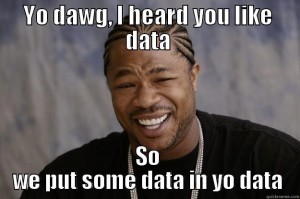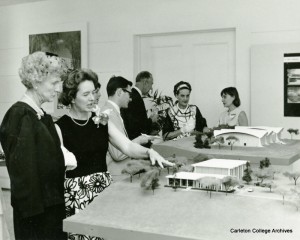The Cowling Rec Center was built in 1965 and was originally the women’s gym. It was designed by Minoru Yamasaki, the same architect who designed Goodhue, West Gym, and Olin Hall.
My experience of searching for archival photos of the Elizabeth Cowling Recreation Center was less fruitful than I had imagined. I’ve never conducted research in this manner before.
This was my first time searching for photographs instead of text information and my first time looking through archives.
I searched the Carleton College Digital Collections and Carleton College Historical Documents. The gym was not built until the mid-sixties, the Carleton College Archival Photos did not bring up any results since all those archival photos were taken between 1871 and 1955.
My search results yielded mostly photos of the women’s gymnastics team performing inside of the gym instead of the outside of the building. So in total I found three images depicting the outer architecture. Two were black and white photos taken of the gym. Both were taken of the front of the building: one from the east and one from the west.
 After saving the images on the computer, I proceeded to document the metadata. Metadata is the information about a piece of data. Most items were straightforward. It was easy to find the title, paste the necessary URLs, and write up a short description.
After saving the images on the computer, I proceeded to document the metadata. Metadata is the information about a piece of data. Most items were straightforward. It was easy to find the title, paste the necessary URLs, and write up a short description.
When I recorded the metadata on a spreadsheet I listed the ID as the name of the image file in accordance with the metadata guidelines I followed. However, the website hosting the photos listed ID as: 20110615_5_Yamasaki/data/originals/cowling. That led to some confusion. The other metadata items I struggled with were Creator and Rights since there was no mention of either on the image source webpage.
 The last picture I found was not of the physical building, but rather of some ladies looking at a small model of the building. The webpage listed information on the digital image including the specific folders and boxes where the physical photograph can be found. I was unsure of the best category for this information so I added an extra row to my metadata table and titled it “Additional Details”.
The last picture I found was not of the physical building, but rather of some ladies looking at a small model of the building. The webpage listed information on the digital image including the specific folders and boxes where the physical photograph can be found. I was unsure of the best category for this information so I added an extra row to my metadata table and titled it “Additional Details”.
Overall, I’d day the pro of collecting data this way is that I can easily rearrange how I present the data in the future. Instead of recording information in just a few words as the image-file name, I have many specific details recorded for each file.
The cons of collecting data this way are that it can be tedious and difficult to find what you’re looking for in the archives. Sometimes items are separated into different series’ so the actual research requires a different approach than that of a typical Google search.
Additionally, the online collections do not include all the items available physically in the archives. I could see that there are architectural drawings of the gym, but they are not available digitally.

I enjoy reading your blog! It is very thorough and detailed. More importantly, I appreciate the fact that you have provided the readers a very specific process that you had to undergo to reach your eventual goal, which provides us a more vivid and truthful understanding, and that you have given us links to the essential topics of this blog, Metadata and Elizabeth Cowling Recreation Center . Though some may find this act pointless, I do find it amusing and attractive that you have inserted that second picture into your blog.
Clarissa, yes the process of finding photos in the online archival collections can be frustrating, as not everything has been digitized. You did manage to find a couple of good shots, but you may need to visit the archives in person to track down a few more in order to model your buildings effectively.
I really like how you led us through your process and the frustrations along the way. Nice post!